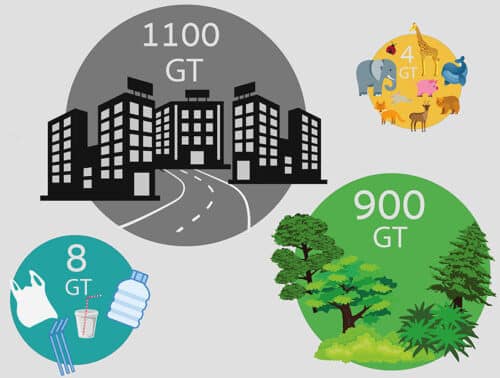During 2020, human products exceeded the mass of all life in our world. The mass of buildings, cars and bottles doubles every 20 years - and the curve is about to flatten

What weighs more in our world - plastic products or animals? Concrete buildings or trees and bushes? From a new study by Weizmann Institute of Science scientists published today in the scientific journal Nature It appears that during the year 2020, human products - from concrete to iPhones - overtook the total mass of plants, bacteria, fungi and in fact all life on earth (the "biomass"). According to the study, the mass of buildings and infrastructure has already overtaken that of all trees and shrubs, while the mass of plastic products is currently twice as large as the mass of all animals. At the current rate, the mass of human products doubles every 20 years, and by the year 2040 the "concrete ocean" will reach more than two trillion tons - double the mass of living creatures in our world.
This is another example of why our current era is called the Anthropocene - that is, the era of man. This is due to its impact, and not only in the narrow area of species extinction.
A century ago, the human product weighed only 3% of the biomass
The research group of Prof. Ron Milo from the Department of Plant and Environmental Sciences tries to understand the world in numbers. BPrevious research of the group, led by Yanon Bar-On, the researchers revealed the total biomass of life on Earth. In the current study led by Emily Elacham and in collaboration with Yaad Ben-Uri, the researchers set out to compare the biomass they found and the anthropomass - the mass of man-made materials. Their findings show that at the beginning of the 20th century, the anthropomass was equal to only about 3% of the total biomass. During these years, humans multiplied at a rapid rate and their number grew fourfold, but their share in the general biomass remained only a fraction: about 0.01%. However, the long hand of humans - that is, their industrial products - has lengthened at a rate much faster than the rate of population growth. So fast, that today every person on the planet produces on average every week anthropomass greater than his body weight.
The surge in the amount of man-made materials received a major boost from the XNUMXs onwards - the period of the "Great Acceleration" after World War II - when building materials such as concrete and gravel became more and more available, and roads, private houses and high-rises began to cover the United States, Europe and other countries . This acceleration has actually continued continuously for more than six decades, with building materials making up the lion's share of the mass growth of human products in these years. At the same time as the jump in anthropomass, there is also a constant erosion of biomass in the form of deforestation, reduction of green areas and the extinction of various species.

"The comparison between the mass of human products and the biomass in the last hundred years, illuminates in a new light the growing impact of human activity on the planet," says Elacham. "The study provides a snapshot of the Earth in 2020 and demonstrates how much our footprint in the world has expanded far beyond the 'size of our shoes'," adds Milo. "This bird's-eye view may help us understand the meaning of our era known as the Anthropocene - the geological period characterized by an unprecedented human impact on the Earth. Our message in the research - both to the policy makers and to the general public - is that it is no longer possible to underestimate the extent of our influence on the world compared to the great and powerful forces of nature. We are a major and influential player, and as they say - with great power comes great responsibility. We hope that once we all have these shocking data in front of our eyes, we will choose, as a species, to take more responsibility for our actions."
More of the topic in Hayadan:
- "The decisions we will make in the next ten years regarding the climate will affect hundreds and even thousands of years"
- How do we know that humanity established the first intelligent civilization on Earth?
- Questions for the future of humanity: What geological imprint will we leave behind?
- Questions for the future of humanity: Can the human race avoid extinction?
